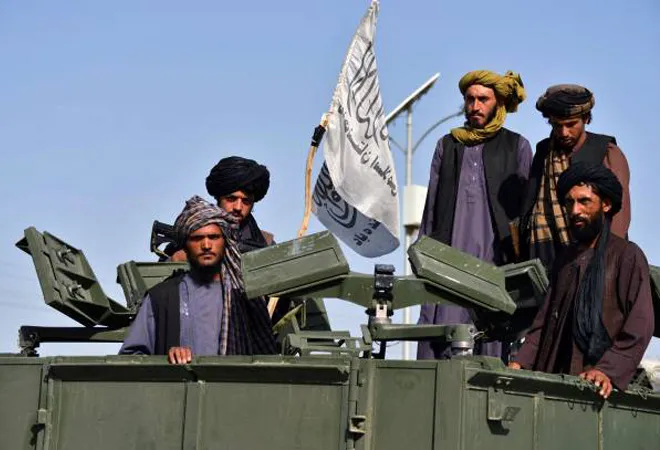 This piece is part of the essay series, Instability in India’s neighbourhood: A multi-perspective analysis
This piece is part of the essay series, Instability in India’s neighbourhood: A multi-perspective analysis
Nine months in, the Taliban administrators are still grappling with consolidating power in Afghanistan. Thus, reports of a reshuffle of the prime ministerial position and a
three-day meeting held in March by the supreme leader, Mawlawi Hebatullah Akundzada in Kandahar, do not come as a surprise given the circumstances in Afghanistan. Zabilullah Mujahid, the spokesperson of the Islamic Emirate was quick to dismiss such speculation by calling it
untrue, yet many believe there are increased divisions.
With rising internal discord and emerging external threats, the Taliban will find it difficult to consolidate power in Afghanistan.
Taliban leadership has prioritised internal cohesion over its outreach to other groups of the Afghan society, even at the cost of much-needed international recognition. With rising internal discord and emerging external threats, the Taliban will find it difficult to consolidate power in Afghanistan. In the case of the Taliban’s failure to maintain control, there will be a rise in violent infighting between factions and opposition groups as they try to take over, further exacerbating the worst humanitarian and economic crisis that the Afghans are facing.
Internal power struggles
The Taliban faced growing factionalism throughout its existence, the tumultuous events of
2015 are a recent example. The revelation of its founder’s death, Mullah Omar in 2013 and his successor Mullah Akhtar Mansour subsequently, sent shock waves through the movement. Creating an environment for new schisms and internal discord to emerge. The group stayed integrated given the loose organisational structure and a great deal of autonomy its militants fighting the Afghan security forces had, maintaining unity despite its membership diversifying over the years.
The majority of the friction between Taliban ranks stems from the differences in its political and military wings. The military-minded Haqqani group is a loyal proxy of Pakistan’s intelligence agency, deeply embedded in the Taliban leadership. Some observers worried that Sirajuddin Haqqani would subvert the movement with Pakistani support.
The Taliban and Haqqani leaders were embroiled in a power struggle days after the government was formed that eventually led to violent confrontations. A major
row broke out between the factions on who did the most to achieve victory. The incident resulted in Mullah Abdul Ghani Baradar’s disappearance for several days following the exchange of strong words with Khalil ur-Rahman Haqqani—the Minister for refugees. The incident led to clashes amongst their followers.
The incident resulted in Mullah Abdul Ghani Baradar’s disappearance for several days following the exchange of strong words with Khalil ur-Rahman Haqqani—the Minister for refugees.
Ideological differences have led to the adoption of conflicting policies by the Taliban. The hardliners made it clear that anyone who spent a day in previous administrations would not be given a place in the Taliban-run government. The Human Rights Watch reported that the Taliban forces were carrying out targeted killings in several provinces of former officials and security personnel. Taliban squads also
forcibly evicted people from their homes in several provinces. Soon after, however, the administration announced that it would welcome back former government officials and technocrats, granting amnesty.
The deep-seated divisions within the Taliban are evident with its decision to permit girls to study till 6th grade. Aiming to place policies compliant with the “principles of Islamic law and Afghan culture”, the regime backtracked from its earlier declarations of allowing education for girls.
Amongst the soldiers who await the spoils of war, there is growing dissatisfaction. Lacking experience and training in any form of governance, they are losing their sense of identity which relied heavily on waging war. To add to their grievances, in October last year, the Taliban’s central leadership established the “clearing of ranks commission”. Aimed at expelling the Taliban fighters who commit crimes and violate Afghan citizens’ privacy.
In a bid to further consolidate its power, the Taliban has enacted changes to Afghanistan’s legal system, robbing Afghans of their right to due process. The Afghanistan Independent Bar Association was stripped of its
independence. Abdul Hakin Sharae published a decree on 23 November 2021 that stated that lawyers and officials must be “honest and loyal to the Islamic Emirate,” not having worked with the previous administration, and having taken part in the “jihad”. It went on to state that those who do not meet these standards would be replaced. Leaving very few, non-Taliban figures eligible for positions.
Threats from external entities
Apart from challenges within the group, the Taliban faces external threats from terrorist outfits such as the Islamic State-Khorasan( IS-K) and National Resistance Front (NRF), an anti-Taliban group consisting of former government leaders.
Afghanistan now provides a permissive environment for the IS-K to rebuild given the Taliban’s limited ability to govern, the absence of multilateral counterterrorism pressures, and the spiralling humanitarian crisis.
Islamic State-Khorasan (IS-K):
Inactive since November last year, the IS-K has launched an aggressive campaign to undermine the governance of the Afghan Taliban over the last couple of weeks. The most notable was the high school
bomb blast in Dasht-e-Barchi, a predominately Hazara Shiite neighbourhood. The attack left six dead and at least 11 injured including children.
The Taliban’s counterinsurgency has managed to reduce IS-K’s territory and manpower. Forcing the Afghan Taliban’s rivals to focus on operations in urban centres such as the deadly attack at the Kabul airport in August 2021. Despite being weak, the IS-K leadership’s dedication to carrying out attacks has signalled its potential to pose a challenge to the Taliban. Afghanistan now provides a permissive environment for the IS-K to rebuild given the Taliban’s limited ability to govern, the absence of multilateral counterterrorism pressures, and the spiralling humanitarian crisis.
To destabilise the Taliban’s control, the IS-K has exposed the Taliban’s heavy-handed approach to counterinsurgency. Crackdowns and reprisals against locals deemed to be supporting the IS-K are commonplace, further alienating the locals. Additionally, the IS-K has forged ties with local militias in need of jihadi alliances and recruited from communities aggrieved with the Taliban.
Coopting of groups like Lashkar-e-Jhangvi and the Islamic Movement of Uzbekistan provided IS-K with expanded expertise and regional geographical knowledge, and curtailed competition for recruits. A key figure in the group
Al-Muhajir played an instrumental role in revamping the group, strengthening its ability to oppose the Afghan Taliban.
Many anti-Taliban forces within the US-trained armed forces and the former members of the Ghani administration fled to the Panjshir valley, a bastion of anti-Taliban resistance.
The now Deputy Head of the IS-K’s Kabul network, al-Muhajir, was previously part of Taliban factions affiliated with the Haqqani network. His extensive networks have facilitated the groups’ recruitment and his urban warfare expertise has proved useful considering he was the
mastermind behind the Kabul airport attacks. As long as the Taliban fail to devise an effective mechanism to reconcile with former Afghan forces, the pool of thousands of former Afghan security officers, fearful and without any prospects, represents an untapped opportunity for IS-K to rebuild itself stronger than ever before.
National Resistance Front (NRF)
Many anti-Taliban forces within the US-trained armed forces and the former members of the Ghani administration fled to the Panjshir valley, a bastion of anti-Taliban resistance. Various other opposition leaders
fled to the bordering state of Tajikistan last year seeking refuge.
Once a stronghold for the insurgency against the Soviet occupation in the 1980s, the Panjshir valley was targeted by the Taliban in a major offensive to wane out the resistance in September 2021. Ahmad Massoud, the leader of the NRF, vowed to
continue fighting despite the devastating loss to the movement. Another prominent leader in the former Afghan Vice President Amrullah Saleh. The NRFinsisted Massoud be the sole leader and former soldiers of the now-defunct Afghan National Security and Defense forces filled the ranks of the combatants.
Unlike the IS-K, the NRF is not a serious threat to the Taliban. However, they have announced a spring offensive. The NRF also has lacked political and material support from external powers, which is integral to sustaining a successful insurgent campaign. Neighbouring Tajikistan is the only country in Central Asia that openly opposes the Taliban and provides a sanctuary for Afghan opposition leaders.
In light of the devastating humanitarian and economic crisis, topped with the growing need for international recognition, the Taliban may be far from consolidating its power as governing is more demanding than waging an insurgency.
Whither to?
The Taliban have waged one of the longest insurgencies and have emerged as a relatively cohesive group, thwarting seeds of resistance. Mass defections to IS-K, the Haqqani network declaring independence, or dissatisfied individuals defecting to other groups have caused concerns. However, its social policy indicates the Taliban’s refusal to engage in initiatives that could damage the movement’s unity.
It is early for a cohesive resistance movement, however, it is still a possibility. Taliban had previously suppressed internal division with a heavy hand and managed to emerge united. The difference this time is that the people of Afghanistan are not what they were two decades ago and have made major strides to progress as a society. In light of the devastating humanitarian and economic crisis, topped with the growing need for international recognition, the Taliban may be far from consolidating its power as governing is more demanding than waging an insurgency.
Instead of watching the Taliban clash with IS-K, countries interested in countering the IS-K have to proactively develop a joint security mechanism. This is the need of the hour as the people of Afghanistan continue to suffer as they face a deteriorating security environment with an increased likelihood of mass civilian displacement in light of the intensifying IS-K and Afghan Taliban antagonism.
The views expressed above belong to the author(s). ORF research and analyses now available on Telegram! Click here to access our curated content — blogs, longforms and interviews.



 This piece is part of the essay series,
This piece is part of the essay series,  PREV
PREV


